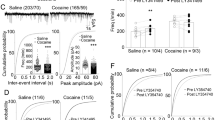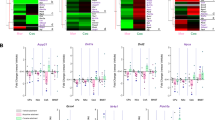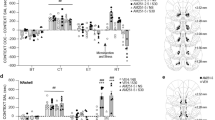Abstract
Opioid abuse is a rapidly growing public health crisis in the USA. Despite extensive research in the past decades, little is known about the etiology of opioid addiction or the neurobiological risk factors that increase vulnerability to opioid use and abuse. Recent studies suggest that the type 2 metabotropic glutamate receptor (mGluR2) is critically involved in substance abuse and addiction. In the present study, we evaluated whether low-mGluR2 expression may represent a risk factor for the development of opioid abuse and addiction using transgenic mGluR2-knockout (mGluR2-KO) rats. Compared to wild-type controls, mGluR2-KO rats exhibited higher nucleus accumbens (NAc) dopamine (DA) and locomotor responses to heroin, higher heroin self-administration and heroin intake, more potent morphine-induced analgesia and more severe naloxone-precipitated withdrawal symptoms. In contrast, mGluR2-KO rats displayed lower motivation for heroin self-administration under high price progressive-ratio (PR) reinforcement conditions. Taken together, these findings suggest that mGluR2 may play an inhibitory role in opioid action, such that deletion of this receptor results in an increase in brain DA responses to heroin and in acute opioid reward and analgesia. Low-mGluR2 expression in the brain may therefore be a risk factor for the initial development of opioid abuse and addiction.
Similar content being viewed by others
Log in or create a free account to read this content
Gain free access to this article, as well as selected content from this journal and more on nature.com
or
References
World Health Organization. Management of substance abuse: Opiates. 2018 http://www.who.int/substance_abuse/facts/opiates/en/. Accessed 15 August 2018.
Department of Health and Human Services. About the U.S. Opioid Epidemic. 2018. https://www.hhs.gov/opioids/about-the-epidemic/. Accessed 15 August 2018.
American Psychiatric Association. Diagnostic and statistical manual of mental disorders. 5th ed. Arlington, VA: American Psychiatric Publishing; 2013.
American Society of Addiction Medicine. Opioid Addiction 2016 Facts & Figures. 2016. https://www.asam.org/docs/default-source/advocacy/opioid-addiction-disease-facts-figures.pdf. Accesssed 15 August 2018.
Jordan CJ, Andersen SL. Sensitive periods of substance abuse: early risk for the transition to dependence. Dev Cog Neurosci. 2017;25:29–44.
Chartoff EH, Connery HS. It’s MORe exciting than mu: crosstalk between mu opioid receptors and glutamatergic transmission in the mesolimbic dopamine system. Front Pharmacol. 2014;5:116.
Fields HL, Margolis EB. Understanding opioid reward. Trends Neurosci. 2015;38(4):217–25.
Wise RA. Dopamine and reward: the anhedonia hypothesis 30 years on. Neurotox Res. 2008;14(2–3):169–83.
Swendsen J, Le Moal M. Individual vulnerability to addiction. Ann NY Acad Sci. 2011;1216:73–85.
Kalivas PW. The glutamate homeostasis hypothesis of addiction. Nat Rev Neurosci. 2009;10(8):561–72.
Moussawi K, Kalivas PW. Group II metabotropic glutamate receptors (mGlu2/3) in drug addiction. Eur J Pharmacol. 2010;639(1–3):115–22.
Pomierny-Chamiolo L, Miszkiel J, Frankowska M, Pomierny B, Niedzielska E, Smaga I, et al. Withdrawal from cocaine self-administration and yoked cocaine delivery dysregulates glutamatergic mGlu5 and NMDA receptors in the rat brain. Neurotox Res. 2015;27(3):246–58.
Caprioli D, Justinova Z, Venniro M, Shaham Y. Effect of novel allosteric modulators of metabotropic glutamate receptors on drug self-administration and relapse: a review of preclinical studies and their clinical implications. Biol Psychiatry. 2018;84:180–92.
Greenslade RG, Mitchell SN. Selective action of (-)-2-oxa-4-aminobicyclo[3.1.0]hexane-4,6-dicarboxylate (LY379268), a group II metabotropic glutamate receptor agonist, on basal and phencyclidine-induced dopamine release in the nucleus accumbens shell. Neuropharmacology . 2004;47(1):1–8.
Bossert JM, Busch RF, Gray SM. The novel mGluR2/3 agonist LY379268 attenuates cue-induced reinstatement of heroin seeking. Neuroreport . 2005;16(9):1013–6.
Baharlouei N, Sarihi A, Komaki A, Shahidi S, Haghparast A. Blockage of acquisition and expression of morphine-induced conditioned place preference in rats due to activation of glutamate receptors type II/III in nucleus accumbens. Pharmacol Biochem Behav. 2015;135:192–8.
Baharlouei N, Sarihi A, Moradi M, Zarrabian S, Haghparast A. Microinjection of the mGluR2/3 agonist, LY379268, into the nucleus accumbens attenuates extinction latencies and the reinstatement of morphine-induced conditioned place preference in rats. Behav Pharmacol. 2018.
Bossert JM, Gray SM, Lu L, Shaham Y. Activation of group II metabotropic glutamate receptors in the nucleus accumbens shell attenuates context-induced relapse to heroin seeking. Neuropsychopharmacology . 2006;31(10):2197–209.
Bossert JM, Liu SY, Lu L, Shaham Y. A role of ventral tegmental area glutamate in contextual cue-induced relapse to heroin seeking. J Neurosci. 2004;24(47):10726–30.
Chiechio S. Modulation of chronic pain by metabotropic glutamate receptors. Adv Pharmacol. 2016;75:63–89.
Zammataro M, Chiechio S, Montana MC, Traficante A, Copani A, Nicoletti F, et al. mGlu2 metabotropic glutamate receptors restrain inflammatory pain and mediate the analgesic activity of dual mGlu2/mGlu3 receptor agonists. Mol Pain. 2011;7:6.
Osikowicz M, Mika J, Makuch W, Przewlocka B. Glutamate receptor ligands attenuate allodynia and hyperalgesia and potentiate morphine effects in a mouse model of neuropathic pain. Pain . 2008;139(1):117–26.
Wu X, Shi M, Wei C, Yang M, Liu Y, Liu Z, et al. Potentiation of synaptic strength and intrinsic excitability in the nucleus accumbens after 10 days of morphine withdrawal. J Neurosci Res. 2012;90(6):1270–83.
Rasmussen K, Hsu MA, Vandergriff J. The selective mGlu2/3 receptor antagonist LY341495 exacerbates behavioral signs of morphine withdrawal and morphine-withdrawal-induced activation of locus coeruleus neurons. Neuropharmacology. 2004;46(5):620–8.
Yang HJ, Zhang HY, Bi GH, He Y, Gao JT, Xi ZX. Deletion of type 2 metabotropic glutamate receptor decreases sensitivity to cocaine reward in rats. Cell Rep. 2017;20(2):319–32.
Xi ZX, Peng XQ, Li X, Song R, Zhang HY, Liu QR, et al. Brain cannabinoid CB(2) receptors modulate cocaine’s actions in mice. Nat Neurosci. 2011;14(9):1160–6.
Richardson NR, Roberts DC. Progressive ratio schedules in drug self-administration studies in rats: a method to evaluate reinforcing efficacy. J Neurosci Methods. 1996;66(1):1–11.
Zhan J, Jordan CJ, Bi GH, He XH, Gardner EL, Wang YL et al. Neuropharmacology genetic deletion of the dopamine D3 receptor increases vulnerability to heroin in mice. Neuropharmacology. 2018;141:11–20.
Gellert VF, Holtzman SG. Development and maintenance of morphine tolerance and dependence in the rat by scheduled access to morphine drinking solutions. J Pharmacol Exp Ther. 1978;205(3):536–46.
Lynch WJ, Carroll ME. Regulation of drug intake. Exp Clin Psychopharmacology. 2001;9(2):131–143.
Volkow ND, Fowler JS, Wang GJ, Baler R, Telang F. Imaging dopamine’s role in drug abuse and addiction. Neuropharmacology. 2009;56:3–8.
Song R, Zhang HY, Li X, Bi GH, Gardner EL, Xi ZX. Increased vulnerability to cocaine in mice lacking dopamine D3 receptors. Proc Natl Acad Sci USA. 2012;109(43):17675–80.
Volkow ND, Fowler JS, Wang GJ. Role of dopamine in drug reinforcement and addiction in humans: results from imaging studies. Behav Pharmacol. 2002;13(5–6):355–66.
Zhou Z, Karlsson C, Liang T, Xiong W, Kimura M, Tapocik JD, et al. Loss of metabotropic glutamate receptor 2 escalates alcohol consumption. Proc Natl Acad Sci USA. 2013;110(42):16963–8.
Li X, Hoffman AF, Peng XQ, Lupica CR, Gardner EL, Xi ZX. Attenuation of basal and cocaine-enhanced locomotion and nucleus accumbens dopamine in cannabinoid CB1-receptor-knockout mice. Psychopharmacology. 2009;204(1):1–11.
Piazza PV, Deminiere JM, le Moal M, Simon H. Stress- and pharmacologically induced behavioral sensitization increases vulnerability to acquisition of amphetamine self-administration. Brain Res. 1990;514(1):22–6.
Piazza PV, Deroche-Gamonent V, Rouge-Pont F, Le Moal M. Vertical shifts in self-administration dose–response functions predict a drug-vulnerable phenotype predisposed to addiction. J Neurosci. 2000;20(11):4226–32.
Volkow ND, Wang GJ, Fowler JS, Tomasi D, Telang F, Baler R. Addiction: decreased reward sensitivity and increased expectation sensitivity conspire to overwhelm the brain’s control circuit. Bioessays. 2010;32(9):748–55.
Ward SJ, Morgan D, Roberts DC. Comparison of the reinforcing effects of cocaine and cocaine/heroin combinations under progressive ratio and choice schedules in rats. Neuropsychopharmacology. 2005;30(2):286–95.
Testa CM, Friberg IK, Weiss SW, Standaert DG. Immunohistochemical localization of metabotropic glutamate receptors mGluR1a and mGluR2/3 in the rat basal ganglia. J Comp Neurol. 1998;390(1):5–19.
Berube-Carriere N, Riad M, Dal Bo G, Levesque D, Trudeau LE, Descarries L. The dual dopamine-glutamate phenotype of growing mesencephalic neurons regresses in mature rat brain. J Comp Neurol. 2009;517(6):873–91.
Yamaguchi T, Qi J, Wang HL, Zhang S, Morales M. Glutamatergic and dopaminergic neurons in the mouse ventral tegmental area. Eur J Neurosci. 2015;41(6):760–72.
LaLumiere RT, Kalivas PW. Glutamate release in the nucleus accumbens core is necessary for heroin seeking. J Neurosci. 2008;28(12):3170–7.
Shen HW, Scofield MD, Boger H, Hensley M, Kalivas PW. Synaptic glutamate spillover due to impaired glutamate uptake mediates heroin relapse. J Neurosci. 2014;34(16):5649–57.
Knackstedt LA, Kalivas PW. Glutamate and reinstatement. Curr Opin Pharmacol. 2009;1:59–64.
Diana M, Muntoni AL, Pistis M, Melis M, Gessa GL. Lasting reduction in mesolimbic dopamine neuronal activity after morphine withdrawal. Eur J Neurosci. 1999;11(3):1037–41.
Sun L, Hu L, Li Y, Cui C. Mesoaccumbens dopamine signaling alteration underlies behavioral transition from tolerance to sensitization to morphine rewarding properties during morphine withdrawal. Brain Struct Funct. 2014;219(5):1755–71.
Qi J, Zhang S, Wang HL, Barker DJ, Miranda-Barrientos J, Morales M. VTA glutamatergic inputs to nucleus accumbens drive aversion by acting on GABAergic interneurons. Nat Neurosci. 2016;19(5):725–33.
Meyer PJ, Morgan MM, Kozell LB, Ingram SL. Contribution of dopamine receptors to periaqueductal gray-mediated antinociception. Psychopharmacology. 2009;204(3):531–40.
Magnusson JE, Fisher K. The involvement of dopamine in nociception: the role of D(1) and D(2) receptors in the dorsolateral striatum. Brain Res. 2000;855(2):260–6.
Altier N, Stewart J. Dopamine receptor antagonists in the nucleus accumbens attenuate analgesia induced by ventral tegmental area substance P or morphine and by nucleus accumbens amphetamine. J Pharmacol Exp Ther. 1998;285(1):208–15.
Koch T, Hollt V. Role of receptor internalization in opioid tolerance and dependence. Pharmacol Ther. 2008;117(2):199–206.
Williams JT, Ingram SL, Henderson G, Chavkin C, von Zastrow M, Schulz S, et al. Regulation of mu-opioid receptors: desensitization, phosphorylation, internalization, and tolerance. Pharmacol Rev. 2013;65(1):223–54.
Yu G, Zhang FQ, Tang SE, Lai MJ, Su RB, Gong ZH. Continuous infusion versus intermittent bolus dosing of morphine: a comparison of analgesia, tolerance, and subsequent voluntary morphine intake. J Psychiatr Res. 2014;59:161–6.
Wang XF, Barbier E, Chiu YT, He Y, Zhan J, Bi GH, Zhang HY, Feng B, Liu-Chen LY, Wang JB, Xi ZX. T394A mutation at the μ opioid receptor blocks opioid tolerance and increases vulnerability to heroin self-administration in mice. J Neurosci. 2016;36:10392–403.
Sepulveda MJ, Hernandez L, Rada P, Tucci S, Contreras E. Effect of precipitated withdrawal on extracellular glutamate and aspartate in the nucleus accumbens of chronically morphine-treated rats: an in vivo microdialysis study. Pharmacol Biochem Behav. 1998;60(1):255–62.
Sepulveda J, Oliva P, Contreras E. Neurochemical changes of the extracellular concentrations of glutamate and aspartate in the nucleus accumbens of rats after chronic administration of morphine. Eur J Pharmacol. 2004;483(2–3):249–58.
Zhu H, Rockhold RW, Ho IK. The role of glutamate in physical dependence on opioids. Jpn J Pharmacol. 1998;76(1):1–14.
Robbe D, Bockaert J, Manzoni OJ. Metabotropic glutamate receptor 2/3-dependent long-term depression in the nucleus accumbens is blocked in morphine withdrawn mice. Eur J Neurosci. 2002;16(11):2231–5.
Spanagel R. Animal models of addiction. Dialogues Clin Neurosci. 2017;19(3):247–58.
Andres JI, Alcazar J, Cid JM, De Angelis M, Iturrino L, Langlois X, et al. Synthesis, evaluation, and radiolabeling of new potent positive allosteric modulators of the metabotropic glutamate receptor 2 as potential tracers for positron emission tomography imaging. J Med Chem. 2012;55(20):8685–99.
Lohith T, McQuade P, Salinas C, Anderson M, Reynders T, Bautmans A et al. First-in-human PET imaging of mGluR2 receptors. J Nucl Med. 2016;57:213.
Funding
This research was supported by the Intramural Research Program (IRP) of the National Institute on Drug Abuse (NIDA) (Z1A DA000478), National Institutes of Health (NIH).
Author contributions
J.T.G., C.J.J., E.G., and Z.-X. X. designed the experiments. J.T.G., H.J.Y., G.H.B., and Y.H. performed the experiments. J.T.G., C.J.J., and Z.X.X. analyzed the data and prepared the figures. C.J.J. and Z.-X. X. wrote the manuscript.
Author information
Authors and Affiliations
Corresponding author
Ethics declarations
Competing interests
The authors declare no competing interests.
Additional information
Publisher's note: Springer Nature remains neutral with regard to jurisdictional claims in published maps and institutional affiliations.
Rights and permissions
About this article
Cite this article
Gao, JT., Jordan, C., Bi, GH. et al. Deletion of the type 2 metabotropic glutamate receptor increases heroin abuse vulnerability in transgenic rats. Neuropsychopharmacol 43, 2615–2626 (2018). https://doi.org/10.1038/s41386-018-0231-5
Received:
Revised:
Accepted:
Published:
Issue date:
DOI: https://doi.org/10.1038/s41386-018-0231-5
This article is cited by
-
A highly D3R-selective and efficacious partial agonist (S)-ABS01-113 compared to its D3R-selective antagonist enantiomer (R)-ABS01-113 as potential treatments for opioid use disorder
Neuropsychopharmacology (2022)
-
Rat models of human diseases and related phenotypes: a systematic inventory of the causative genes
Journal of Biomedical Science (2020)
-
Operant self-stimulation of thalamic terminals in the dorsomedial striatum is constrained by metabotropic glutamate receptor 2
Neuropsychopharmacology (2020)
-
Non-Opioid Treatments for Opioid Use Disorder: Rationales and Data to Date
Drugs (2020)



